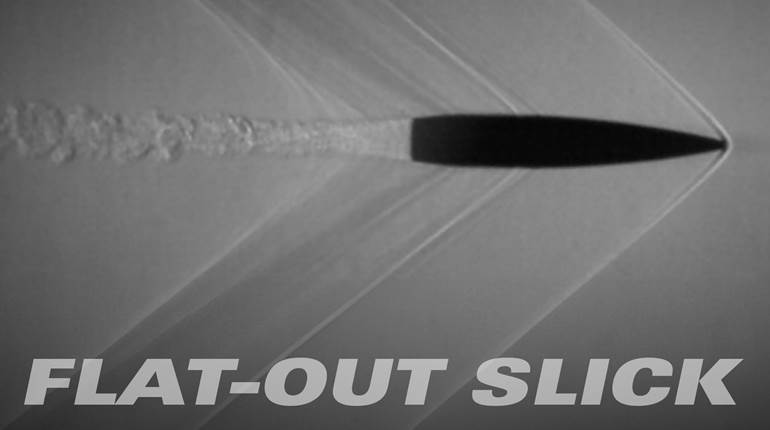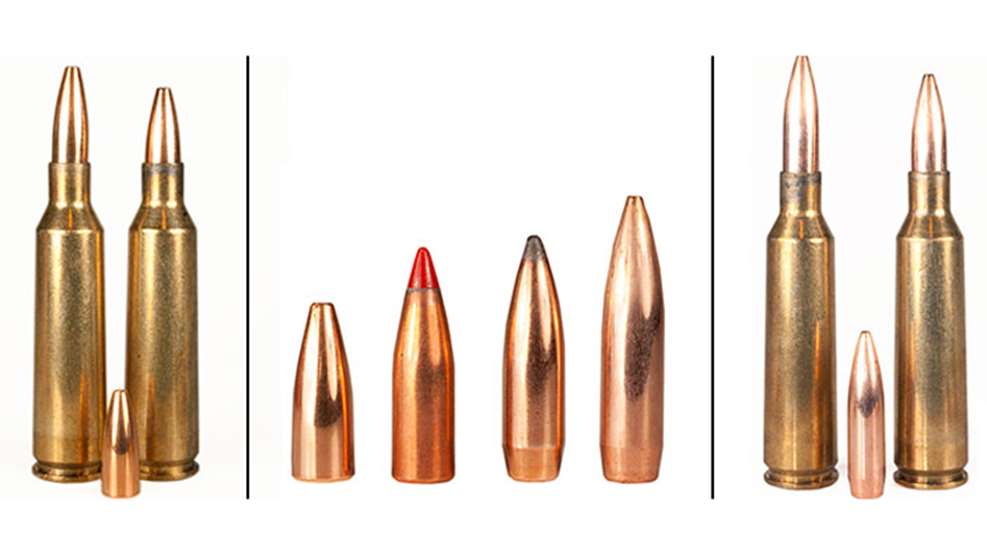
Top image: (left group) The Berger 40-gr. bullet is barely in the case neck when seated to nearly engage the rifling of the .22-250. A deeper- seated bullet (right) ensures that the bullet remains secure during rough handling. (center group) These four bullets cover all the intended uses for the author’s new rifle. They are (from left): Berger 40-gr. FB Varmint; Hornady 55-gr. V-MAX; Sierra 65-gr. SBT GameKing; and Nosler Custom Competition 77-gr. Hollow Point Boat Tail. (right group) The cartridge on the left has a Nosler 77-gr. HPBT bullet seated at Nosler’s recommended depth. However, the new Sisk .22-250 rifle required deeper seating of the projectile (right).
For handloaders, part of the pleasure of a new rifle is developing handloads that maximize its effectiveness in the roles for which it was purchased. This task should be a relaxed undertaking, researching the cartridge and appropriate bullets to be matched with three or four suitable propellants and shooting them to determine the best combinations.
It was with exactly that goal in mind that I approached my newest gun. I had great expectations for it, especially since it was chambered in the versatile .22-250 Rem.—an excellent cartridge for ground squirrels and predators, and a decent one for pronghorns and whitetail deer. The rifle was made by Charlie Sisk of Sisk Rifles (siskguns.com), based on a Stiller’s Precision Firearms short Predator action. Sisk turned a Lilja barrel to a sporter-weight contour and cut it to 22". The barrel has a 1:8" RH rifling twist, which allows shooting nearly the full range of .22-cal. bullet weights. The action and barrel are coated with black Cerakote and held in a High Tech Specialties Classic synthetic stock with a cheekpiece.
Setting out to prove the mettle of both rifle and cartridge in entirely dissimilar roles, I decided to develop four different loads. They start with a load using a lightweight bullet that gave flat enough trajectory to connect, out to several hundred yards, with the tiny kill zone of ground squirrels while also preventing undue wear on the bore. Another load uses a heavier bullet at full power and a moderate pace. I developed it for marmots, coyotes and red fox. Yet another carries a fairly heavy bullet that should allow the .22-250 (where legal) to perform acceptably well on big game, although there are certainly better choices. Finally, I put together a load capped with a long, streamlined bullet that should help me connect on targets way out there where the wind only stops to change direction.
In each case, I went through a process of selecting suitable propellants and charge weights, adjusting seating depth based on bullet length and proximity to the barrel’s rifling, and confirming the best loads through accuracy testing. Here’s what I found.
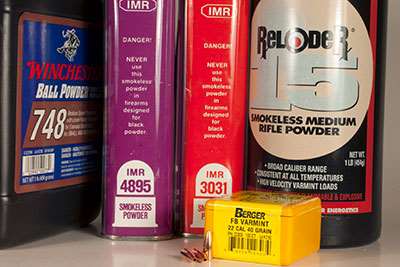
Propellant Picks
While a few Internet firearm blogs are entertaining, load data from such sources should be steered around like summer roadkill. One Internet “expert” included a load for his .257 Roberts Improved that fired 70-gr. bullets at 3,900 f.p.s. That dangerously excessive load is proof that guardian angel wings shield those of arrested development—at least up to a point.
That point will be reached by following the old advice of developing a maximum load by using factory data and increasing propellant weight until signs of excessive pressure appear, then reducing charge weight a grain and calling it good. When a powder charge develops flattened or cratered primers or stiff bolt lift, chances are maximum pressure was surpassed well below that powder weight.
In contrast, handloading manuals contain safe load data that required untold hours and money to develop. Nosler and Sierra bullet manuals even list accurate bullet and powder combinations.
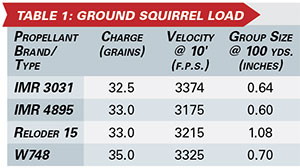 For ground squirrel shooting I wanted a 40-gr. bullet with a mild velocity of about 3400 f.p.s. Accurate, reduced-velocity loads are the most difficult to develop because at lower pressures propellants fail to burn as cleanly, causing velocities to vary and accuracy to suffer. With Berger 40-gr. FB Varmint bullets I tried low weights of four powders, and this is how they shot from the .22-250:
For ground squirrel shooting I wanted a 40-gr. bullet with a mild velocity of about 3400 f.p.s. Accurate, reduced-velocity loads are the most difficult to develop because at lower pressures propellants fail to burn as cleanly, causing velocities to vary and accuracy to suffer. With Berger 40-gr. FB Varmint bullets I tried low weights of four powders, and this is how they shot from the .22-250:
Bullet Seating Depth
The SAAMI-established maximum cartridge length for the .22-250 Rem. is 2.350". Seating a bullet to a longer overall length can increase pressure because it has less or no free-start toward the rifling. Conversely, seating a bullet to a shorter overall length can also increase pressure as the bullet will intrude into powder space. That’s why it’s always prudent, no matter what bullet weight and overall cartridge length you settle on, to start load development several grains below the maximum listed in handloading manuals.
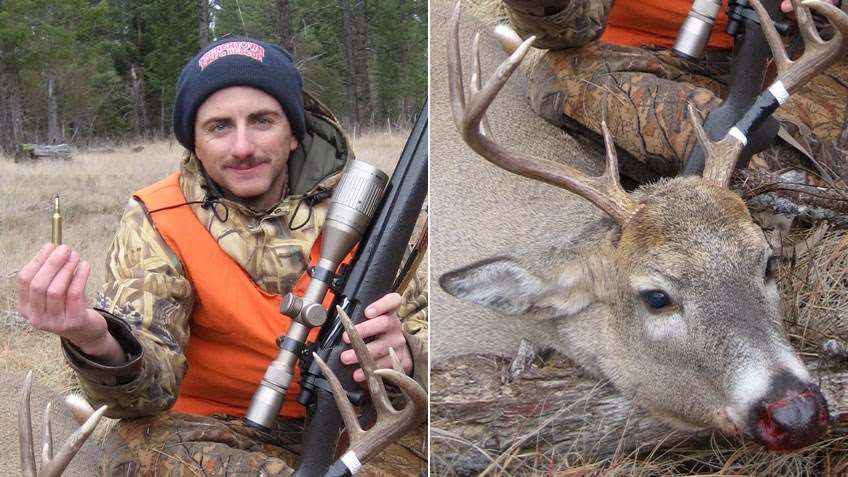
The Nosler reloading manual recommends a cartridge length of 2.60" for its 77-gr. hollow point boattail bullet. That cartridge length would wedge that bullet into the rifling of my .22-250. For easy extraction of an unfired cartridge, those bullets were seated to a cartridge length of 2.49". Target shooters commonly seat bullets so that they contact the rifling lands, or are even slightly wedged into them, as a means of ensuring that the bullets enter the rifling evenly when the cartridge is fired. Hunters shouldn’t follow that example because their cartridges may have to be repeatedly snapped into a magazine, shoved into the chamber and yanked back out before they are fired, often times affecting their concentricity. The Berger 40-gr. bullets are rather short, and would be hanging on by a thread in a case neck if seated in close contact with the rifling lands in the Sisk rifle. Seating them 0.13" from contacting the rifling keeps a good portion of their shank in the case neck, holding the bullets tight and straight and lending them a measure of durability under hunting conditions.
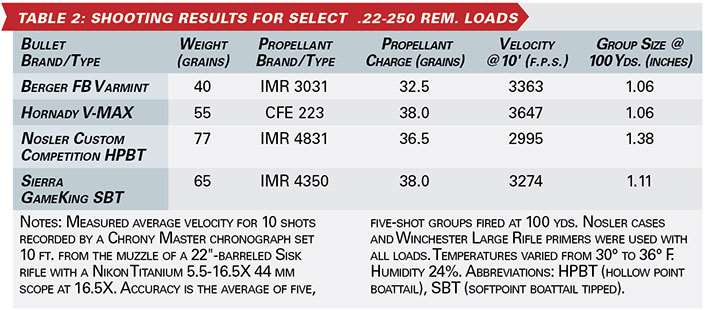
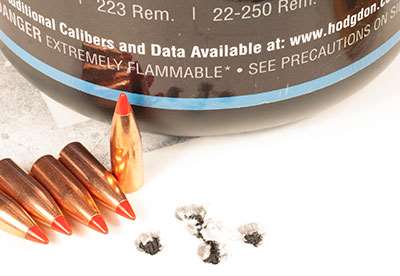
Shooting
Several shooting methods help select the best handloads. The ladder test uses cartridges loaded with increasing amounts of powder to find where consecutive bullets impact at the same point at 300 yds. This allows the shooter to find the sweet spot of the barrel vibration. Another technique uses three to five cartridges, each batch loaded with increasing amounts of powder. One target is reserved for each charge weight. But one shot at a time is fired at the target while rotating through the cartridges containing different powder weights. That highlights problems caused by barrel heating and fouling, as well as the bugaboo of shooter fatigue.
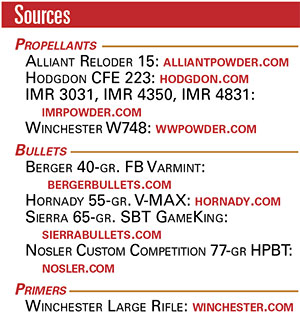 Firing a three-shot group from a hunting rifle or a five-shot group for varmint and target rifles is still one of the best approaches. If a load shows promise, further shooting verifies it was not a fluke of my wiggles compensating for my wobbles. American Rifleman’s protocol, though, calls for five consecutive, five-shot groups to maintain that certainty.
Firing a three-shot group from a hunting rifle or a five-shot group for varmint and target rifles is still one of the best approaches. If a load shows promise, further shooting verifies it was not a fluke of my wiggles compensating for my wobbles. American Rifleman’s protocol, though, calls for five consecutive, five-shot groups to maintain that certainty.
I paired CFE 223 and Varget with Hornady 55-gr. V-MAX bullets in my new rifle. Accuracy was great with Varget, but velocity was slow. Velocity increased 250 f.p.s with CFE 223, with groups only a shade wider.
With the pleasurable work of developing loads finished and the top picks in hand, I expect to enjoy a lasting partnership with my new Sisk rifle at the range and in the field for months and years to come—that is if I can get it back from my son.













